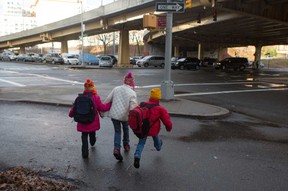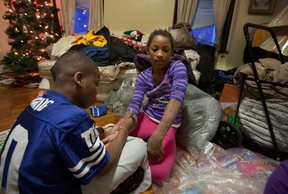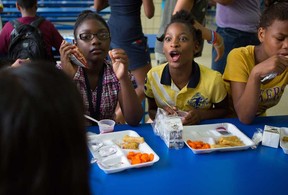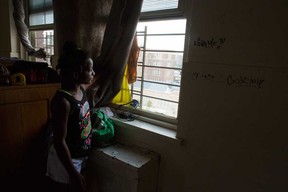Turtle Trying to Flip Over Man Pushing Agains Car Cartoon
Dasani and seven siblings are part of a 'lost generation' of homeless kids, stuck in a shelter less haven than purgatory
Adults who are homeless often speak of feeling stuck. For children like New York City'due south Dasani, the feel is more similar a free-fall

This is the second in a series; read the beginning piece, an introduction to Dasani and her world, here.
NEW YORK — Gracie Mansion is something of an oddity. In a city with a ii per centum vacancy charge per unit and a shortage of public housing, the mayoral residence sits uninhabited on eleven pristine acres of the Upper E Side.
It has been more than a decade since Mayor Michael R. Bloomberg chose to remain in his opulent townhouse, consigning Gracie Mansion to the status of a museum and venue for borough events.
Dasani knows none of these particulars when she steps through Gracie's doors on a school trip in February. She is looking for the mayor. She wants to encounter him upwards shut, this mysterious Wizard of Oz figure who makes decisions nigh her life from behind a curtain of political power.
It never occurs to Dasani that the mayor does non live there. Who could have a mansion and not live in it?
"Look at that fireplace!" she marvels as her classmates step into the parlor where Bloomberg has given news conferences. The tour guide, a woman wearing gold-clasp earrings and tangerine lipstick, moves the children forth, reminding them not to touch.
They shuffle into the library. Still no mayor. Dasani scans for clues like the FBI agents of her favorite tv show, Criminal Minds. She inspects a phone. "His last telephone call was at 11:15," she whispers.

The tour guide opens French doors onto the veranda where New York'south mayors accept entertained dignitaries from around the world. "It'southward a very gracious style of living," she says. "Very elegant."
What impresses Dasani most are not the architectural details or the gold-bound volumes of Chaucer and Tolstoy, but the astonishing lack of dust.
She runs her hand lightly over the meridian of a Steinway pianoforte.
"I tell you," she says. "This firm is clean."
Dasani was an baby when Bloomberg took office in 2002. Declaring Gracie Mansion "the people's house," he gathered United states$vii-one thousand thousand in individual donations — much of it his ain money —to rehabilitate the pale yellowish 18th-century home, which overlooks the E River. In came new plumbing, floors, lighting and ventilation, forth with exquisite touches like an 1820s chandelier and a four-poster mahogany bed.

Facing that same river, six miles away on the reverse side, is the Auburn Family Residence, the squalid city-run homeless shelter where Dasani has lived for more than than two years. She shares a crowded, mouse-infested room with her parents and seven siblings, who sleep doubled upward on torn mattresses.
Dasani spends her days in the care of some other city establishment: her public schoolhouse in Fort Greene, Brooklyn. The Susan S. McKinney Secondary School of the Arts has suffered its ain troubles under the Bloomberg administration: a shrinking budget and fewer teachers.
Dasani shuttles between Auburn and McKinney, but two blocks apart. They form the cadre of her life and the bedrock of her future, one that is in peril.
Adults who are homeless often speak of feeling "stuck." For children, the feel is more similar a free-autumn. With each passing month, they slip further back in every category known to predict long-term well-existence. They are less likely to graduate from the schools that anchor them, and more likely to end upwards like their parents, their lives circumscribed by teenage pregnancy or shortened by crime and illness.

In the absence of a steady habitation or a reliable parent, public institutions have an outsize influence on the destiny of children like Dasani. Whether she can transcend her circumstances rests greatly on the role, however big or small, that social club opts to play in her life.
The question of public responsibility has gained urgency in recent decades. Past the time Bloomberg was elected, children made up 40 percentage of shelter residents.
"We're non walking abroad from taking intendance of the homeless," the mayor said early on. "I have a responsibility, the urban center has a responsibility, to make sure that the facilities we provide are upwardly to some standards."
The Bloomberg administration set out to revamp the shelter organisation, creating 7,500 units of temporary housing, a database to track the shelter population and a program intended to prevent homelessness with counseling, job preparation and short-term financial aid. The new system also made information technology harder for families to be found eligible for shelter.

For a time, the numbers went down. But in the wake of profound policy changes and a spiraling economic system, more children wound up in shelters than at any time since the creation of the shelter organization in the early 1980s.
While the Bloomberg administration spent United states$5-billion on shelter services, the atmospheric condition at Auburn remained grim. Dasani and her siblings have grown numb to life at the shelter, where pocketknife fights suspension out and crack pipes are left on the bath floor. In the words of their mother, they have "get the place." She has a verb for it: shelternized.
For Dasani, schoolhouse is everything — the provider of meals, on-the-spot nursing care, security and substitute parenting. On the Gracie trip, Dasani wears the Nautica glaze donated by a schoolhouse security baby-sit and matching white gloves bestowed to her that forenoon past the principal.
A school like McKinney can likewise provide a bridge to the wider globe.

Information technology does non matter that Dasani's entire sixth grade must walk a mile to the subway in icy winds, take two trains, then walk another 10 minutes before arriving. This round-trip journey, which occupies much of the day, is a welcome escape.
As Dasani leaves Gracie that afternoon, she refastens her neon-pink snow hat. She has given upwardly on the mayor.
"He lives somewhere else," she says, waving an arm along Due east End Avenue before heading dorsum to the subway.
There is no sign announcing the shelter at 39 Auburn Place, which rises over the neighboring Walt Whitman Houses like an accidental fortress. Its stately, neo-Georgian outside hints at the shelter's erstwhile life as a city hospital.

Two sweeping sycamores shade the archway, where smokers linger under brick arches, flicking cigarette ashes onto an empty, untended lawn. A concrete walkway leads to the heavily guarded front door, where residents pass through a metal detector and their numberless are searched for forbidden objects like canned food, hair dryers and irons.
Visitors are restricted to the bleak anteroom. Upstairs, cries and laughter echo along the dim corridors that Dasani'due south legally blind sister, Nijai, has learned to feel her way around. The shelter is sick equipped to handle the needs of its numerous disabled residents, among them premature infants and severely autistic children.
Yet the manual given to incoming families boasts a "full complement of professional and support personnel" who are "available to assist you 24 hours a day, 7 days per calendar week." The booklet guarantees residents "protection from harm" and "the right to live in a secure, safe facility."

A starkly different Auburn — the one to which Dasani is witness — emerges from stacks of handwritten complaints, calls to 911, internal staff reports and dozens of inspections over the last decade. It is less a haven than a purgatory.
There is the 12-year-old boy who writes, on October. 29, 2012, that a female resident touched "my individual area and I didn't like it." His mother also files a complaint, saying the adult female was showing pornography to children.
The police are never notified.
Nor exercise they hear about a xv-year-one-time daughter who says she was sexually assaulted by a security guard one year earlier. The complaint, written by her mother in Spanish, never appears to take been translated. The pleas of a 12-yr-old girl that same month besides go unreported to the police. She writes of a man who exposes his genitals in a girls' bathroom, making her besides afraid to go back without a parent: "I am still scared that someone volition come up in."

Information technology stands to reason that the complaints of children would exist ignored, given how oftentimes the warnings of inspectors go nowhere.
Over the last decade, city and state inspectors have cited Auburn for more than than 400 violations — many of them repeated — including for inadequate child care, faulty fire protection, insufficient heat, spoiled nutrient, broken elevators, nonfunctioning bathrooms and the presence of mice, roaches, mould, bedbugs, lead and asbestos.
Dasani can pick out the inspectors by their clipboards and focused expressions. They work for the Country Part of Temporary and Disability Assistance, which supervises homeless housing around the state. Given that Auburn is partly funded past the land, these inspectors should presumably hold sway.
Year after year, their reports read like a series of unheeded alarms. Responses by the city's Section of Homeless Services attribute Auburn'southward violations to a lack of money. To the country's complaint, in 2003, that only one staff fellow member is tending to 177 schoolhouse-historic period children in the shelter'south recreation room, the agency responds: "We lack resources for teenagers!"

Auburn's children have withal to assume their parents' air of defeat. The children's complaints recount their fright or discomfort every bit reason plenty for action. The adults write as if no one is listening.
Many sound like the parent in April 2012 who has spotted a expressionless mouse in the cafeteria and asks a janitor to remove it.
The side by side day, the mouse is however there. "A child could take touched it," the parent recounts telling the janitor, to which the janitor laughs and responds, "Well and then yous should have cleaned it up."
There is no place on the inspection forms for the near mutual complaint: the disrespect accorded to residents by the shelter staff. Were there such a box to cheque, it could never capture how these encounters reflect for days, reinforcing the rock-bottom failure that Auburn represents.

Even egregious incidents are sometimes mentioned in passing. Ane mother summarizes her grievance, at the elevation of the course, as "All of my belongs went in garbbage." In explaining how her possessions were discarded, she mentions, tangentially, that her caseworker had "groped" her. She ends the complaint on a conciliatory note: "Peace."
The signature at the bottom belongs to Dasani's female parent, Chanel. Afterward she filed the complaint in September 2011, the worker was taken off her instance, merely kept his task and recently got a raise. Chanel never told Dasani, for fear of passing on the shame she feels whenever she sees the human being.
Similar most children, Dasani absorbs more than her female parent would like. She tin can see how the shelter shrinks Chanel's self-regard. Dasani is at that place when the guards rip through her female parent's carefully folded laundry in the name of "inspection," or when a caseworker dresses her down like a cheeky adolescent. "Sometimes it feels like, 'Why you guys messin' with my mom?'"
Chanel is not the first woman to encounter sexual advances past an Auburn employee. Another resident complains that a security guard is "having sex activity with clients in the restrooms and in his blackness Contrivance Charger." A 2012 letter past country inspectors to the Department of Homeless Services mentions a security supervisor and guards having "improper sexual contact" with a resident.
This environs is especially punishing because that some of Auburn's women have fled violent men. Subsequently a caseworker touched his 46-year-old client on the breast in February 2012, another male employee smiled at her the side by side day and asked "if I was being expert," she wrote in a complaint, adding, "I walk around every solar day feeling violated."
Auburn initially suspended the caseworker, Kenneth Durieux, for 30 days. But he kept his chore for nearly a yr, even afterwards the police charged him with sexual abuse. He was dismissed last January, before pleading guilty to forcible touching.
Just this twelvemonth, in that location accept been some 350 calls to 911 from the shelter — including 24 reported assaults, 4 calls about possible kid corruption and i reporting a rape.
City officials declined to comment on the reports of sexual abuse. They aspect other lapses to the building'due south aging infrastructure, maxim plans are in the works for an upgraded burn down safety organisation, bathrooms and enhanced security. Since Bloomberg took office, the metropolis has spent nearly $10 million on repairs and renovations at Auburn.
In the past decade, Auburn's directors have fared well, receiving raises even as the shelter's bug persisted. Ane former managing director, Susan Nayowith, was promoted to head of client advancement at the Department of Homeless Services.
These kinds of facts are lost on the shelter's children, who run across only what is earlier them — like the Swedish meatballs that come frozen in prepackaged trays or the Cheerios served one nighttime for dinner.
And then there are the elevators, which frequently intermission downward. Fifty-fifty when they are working, children cannot ride them unless accompanied by an adult.
A month earlier the trip to Gracie Mansion, when Dasani's sister Avianna walks into the shelter gasping from an asthma attack, a guard refuses to take her up in the elevator. Dasani lifts her wheezing sister, twice her girth, and carries her up 4 flights of stairs to their room.
Half dozen months later, it will be Dasani who falls gravely ill when the elevators are broken. She rocks and vomits bile one evening, trying to distract herself by watching idiot box. At 3:02 a.k., Chanel calls 911.
She helps Dasani down four sets of stairs before she collapses on a row of chairs in the lobby. In that location is no ambulance, so Chanel calls again. 1 of the guards gets nervous, making a 3rd call to report that the child "is in severe abdominal pain." Two more than calls are placed.
At 4:02 a.m., a full hour later, an ambulance finally arrives to take Dasani to Brooklyn Hospital Centre, where her doctor asks what she concluding ate. Her answer: a shelter dinner of spinach lasagna.
In the years that Dasani has lived in Room 449, metropolis and land inspectors have cited at to the lowest degree thirteen violations there, including the presence of roaches, mice and a lead paint hazard.
Yet when Auburn's staff members comport their own inspections of 449, they focus on the family'south transgressions. The room is plant to be chaotic and insufficiently make clean. There are few mentions of Auburn'southward own lapses – the absence of dividers for privacy or aid with permanent housing. Instead, inspectors focus on the family unit'south forbidden turtle or hidden microwave.
Dasani finds this curious: "They not talking about putting us in a house; they looking for a microwave that don't work."
Lately, it is the family'due south sink, with its rotting wall and leaky pipe, that fails to go fixed. For weeks, the pipe drips through the dark. Finally, Dasani is fed up. She crouches down and examines the pipe as her siblings lookout man. "Nobody idea nigh pushing it in and twisting information technology," she says in her cocksure manner. A few quick jerks and she triumphs. The children squeal.
Information technology goes unremarked that hither, in this shelter with a US$nine-million almanac budget, operated by an agency with more than than 100 times those funds, the plumbing has fallen to an 11-yr-old girl.
Dasani's homeroom at McKinney is a cozy haven of book-lined shelves and inspirational words scrawled in chalk, like "Success does not come without sacrifice and struggle."
Every morning, she quietly tucks her coat and haversack in the classroom closet, a precious ritual for a girl who has no other closet. She and so slips into her small wooden desk, contrary her humanities teacher, Religion Hester.
Hester tin best be described as electric. She paces the room, throwing her arms in the air as her booming voice travels along McKinney'due south hallways. Long subsequently she gave up dreams of interim, her grade is the phase and her students, a rapt audition.
Sometimes she arrives in an Audrey Hepburn updo; other days, she dons the brightly patterned prints procured in Senegal on a trip to "learn the truth most my motherland." She favors expressions similar "Oh my gooney goo hoo!" and "Okie pokie dokie shmokie!"
If a student is stumped, she volition break into improvised song, with the course soon chanting along: "I know you know information technology!" — clap, handclapping – "I know you know information technology!" — handclapping, clap.
Hester knows that students learn when they get excited. Information technology bothers her that McKinney lacks the sophisticated equipment of other public schools. She shelled out more than than $1,000 of her ain coin, as a single mother, to give her classroom a projector and document photographic camera.
When Hester looks around her classroom, she sees a glimpse of her younger self. She was raised by a single female parent in the Marcy projects of Bedford-Stuyvesant, Brooklyn, a monotonous spread of 27 brick buildings with the singular distinction of being where Jay Z grew upward. She could never quite numb herself, like other children did, to the addicts shooting up in the elevator or the dead bodies on gurneys. Her conservancy came at church and school.
In 1979, Hester was 1 of the first black students to be bused from Marcy to the predominantly white Edward R. Murrow High School in Midwood, Brooklyn. Outside, children would chase after her, yelling, "Become back to your neighborhood!" Inside the schoolhouse, she applied herself fastidiously. A teacher made all the difference, guiding her to college applications. She was only 16 when she graduated, jump for SUNY Cortland.
Xxx-iii years and 2 master'southward degrees later, information technology is Hester who searches for the student in need of saving.
She sees promise in Dasani, who landed on the laurels ringlet last fall. But lately, she is skipping homework and arriving moody and tired, if she makes it to school at all.
New York'due south homeless children take an abysmal average attendance rate of 82 percentage, well below what is typically needed to advance to the next grade. Since the start of the school yr, Dasani has already missed a week of class and arrived tardily 13 times.
Her attendance is existence closely tracked past a social worker in the school whose nonprofit organisation, Partnership With Children, offers counseling and other services to some of the city's most vulnerable students.
Hester told Partnership about Dasani. She saw no signal in turning to the school's guidance counselor or psychologist, who serves two other schools. They bound from crunch to crisis, like ER doctors in triage, treating issues that have go acute or irreversible.
Prevention is a luxury reserved for schools with enough counselors. In their absence, McKinney turns to Partnership, which has weathered its own post-recession upkeep cuts and layoffs. Graduate students are filling in every bit interns.
This is how Dasani finds herself sitting across from Roxanne, who is pursuing a master's caste in social piece of work at Fordham University. She has been assigned to lead one-on-one counseling sessions with Dasani.
Dasani has never had a counselor. They run across once a calendar week, passing the fourth dimension playing Mancala equally Roxanne tries to describe Dasani out, which proves far more difficult than any board game. Dasani knows how to deflect questions with humor, avoiding talk almost her family unit and the shelter.
She is likewise studying Roxanne. There is something soft well-nigh this Minnesota native, who uses words like "sweetie" and melts into giggles. Dasani is puzzled by Roxanne's attire — the rumpled shirts and distressed boots that pass for hip in other Brooklyn quarters. Zip she wears seems to match, and nevertheless her clothes are spotless.
This leads Dasani to conclude that Roxanne lives in a clean, suburban domicile similar the kind shown on Criminal Minds, where detectives search for murder clues. It is non the murders themselves that intrigue Dasani so much as the enormous, orderly closets of the offense scenes — closets big enough to live in.
Hester wonders almost these counseling sessions. She finds Roxanne brilliant and devoted, but worries that Dasani will run circles around the intern, whose overriding quality is sweetness.
"I don't demand 'sweetness,'" Hester says. "I need a Ph.D."
Dorsum at the shelter, Dasani spends countless hours with her siblings playing games on a Nintendo Wii. If Dasani could design her ain video game, she would call it "Alive or Dice." The protagonist would exist an eleven-twelvemonth-old girl fighting for her own salvation.
In the kickoff round, she confronts the easy villains — her chores — scrambling to bathe, dress and feed her siblings. She cannot find Baby Lele, who is crying. The infant's tears turn into lethal rocks that fall from the sky, which the daughter must dodge.
Next, she encounters her parents battling social workers in the guise of angry pirates. Chanel tosses magical powers to the daughter, who defeats the pirates, melting them to the ground.
In the 3rd round, she goes to school, finding danger and deliverance. Her math teacher is a supervillain whose weapon is numbers. "10" turns into ten charging porcupines. Downwardly the hall, the girl must rescue Hester from giant, rolling cans. "If she dies, all the kids dice, too."
Finally, the girl faces off against her longtime rival from the projects, a imperial hulk who picks up cars and hurls them. If the daughter survives, she reaches the queen — the principal, Paula Holmes — who decides her future. Winning brings the prize of a new house. Losing means returning to the shelter, "which is death."
"My goal is to make it to the end, but I keep dying," Dasani says.
Information technology is easier for Dasani to think of Auburn every bit the worst possible issue because the alternative — winding upward on the street — is unfathomable. She knows that if she and her siblings were to lose the shelter, they might country in foster care, losing 1 another.
So as bad as it is, the children effort to brand the identify their own. When the lights are on, their room is flatly fluorescent, which prompts them to climb a dresser, remove the plastic lamp cover from the ceiling and color it in with crayons the shades of a rainbow.
When the lights are off, the room assumes a gray aura not unlike, Dasani imagines, the infirmary ward it once was. "This was where they put the crazies," she declares, citing as proof a rusted intercom past the door.
The communal bathroom closest to Dasani is, indeed, reminiscent of 1 Flew Over the Cuckoo's Nest. Tiled in steely light-green, its centerpiece is an old, industrial bathtub with no partition. A limp plastic curtain divides the sole shower from the rest of the bathroom, which is marked past vulgar graffiti and shared past dozens of women and girls, though men sometimes intrude.
The floor is filthy. The children routinely wipe information technology down with bleach stolen from the janitors, as residents are forbidden to bring the cleaning solvent into Auburn. A changing table hangs off its swivel, pointing to the floor similar a slide.
At night, the children hear noises. They are sure Auburn is haunted. Five-year-onetime Papa calls the ghost in their room "I-it." When it is dark, they are far too afraid to utilize the bathroom, so they relieve themselves in a saucepan.
Yet that bathroom has become Dasani's makeshift sanctuary. She practices hip-hop routines across the floor. She sits lonely in the toilet stall, the lid closed beneath her. Sometimes she reads, or just closes her eyes. Her mind feels crowded anywhere else.
Lately, she is worried well-nigh her female parent, who has been summoned on Feb. 13 to an urgent meeting at the Administration for Children'due south Services, the agency tasked with protecting the children.
Photographs of smiling children line the walls of the agency'southward lobby in Bedford-Stuyvesant, where Chanel is greeted by her caseworker, who uses the nickname "Mr. James."
"Nosotros're not having this meeting because nosotros want to have your kids away," he says cheerfully. "We're having this meeting considering we desire you to movement to an flat."
Chanel stares at him. "Why don't you lot ever tell my lawyer about these meetings?" she asks, even though she cannot recall the name of the concluding public defender to represent her.
"You don't need a lawyer to nourish an ACS coming together," he responds.
They ride the elevator up to a conference room, where Chanel is jarred to notice the director of Auburn, Derrick Aiken, waiting. He is there to issue a warning: If Chanel and her husband, Supreme, practise not comply with the Section of Homeless Services' requirements, the family unit may be forced to leave the shelter system. At effect is their public assistance case, which has closed considering Supreme failed to report to a chore placement programme, 1 of dozens of such lapses in the past decade. Currently, the family receives but food stamps and survivor benefits.
An open public help instance allows the agency to exist reimbursed with federal funds, while also making the family eligible for child care and task training — the kind of supports that could help in finding a home.
But the problem for Chanel and Supreme comes down to basic math: Even with ii full-time jobs, on minimum wage, they would have combined salaries of only $2,300 per month — just enough to cover the average rent for a studio in Brooklyn.
New York, information technology often strikes Chanel, has no place for the poor.
Auburn offers plenty of proof. Residents like Jenedra, a home health aide, and her daughter, who works at a Pinkberry in Park Slope, Brooklyn, cannot beget city prices.
The gap betwixt income and housing costs was widening when Bloomberg took part in 2002. The homeless population was also growing. For decades, the urban center had tried to stem the numbers past giving homeless families priority access to public housing, Section eight vouchers and subsidized city apartments. While the policy was in place, only 11.5 percent of the families returned to shelters within v years.
To Bloomberg, priority referrals were an incentive to enter the shelter organisation. "Our own policies needlessly encourage entry and prolong dependence on shelters," he said in 2004.
Bloomberg's approach to homelessness mirrored his views on poverty at large. The mayor'south best-known endeavor was the Eye for Economic Opportunity, which spent US$662-one thousand thousand on poverty prevention programs that emphasized education and job training equally a means to self-reliance.
In line with that agenda, the mayor ended the priority-referrals policy in Nov 2004. Instead, the city began offering homeless families fourth dimension-limited rental aid, including through a plan called Reward. All the same more than than a quarter of them wound up back in shelters once their subsidies ran out.
Among them was Dasani's family. After their $1,481 rent subsidy expired in 2010, they returned to a shelter system that spends roughly $iii,000 per month on every family. It would end up costing the city $400,000 to house Dasani's family over a decade.
In 2011, Bloomberg ended Advantage after the country withdrew its funding. Six months later, the city's homeless population hit a record that included more 16,000 children, many of whom had been homeless before.
These children accept come to be known, amid the urban center'south homeless advocates, as "the lost generation."
Dasani is well versed in urban center politics, merely not considering she follows the news. She is just forced to observe what other children miss.
When Bloomberg tried to ban the sale of big, sugary drinks, Dasani began calculating what two sodas would cost in place of the supersize cup that, in her family, is typically passed among eight pocket-size mouths.
Now information technology is the citywide jitney strike that has called Dasani'southward attention, by virtue of the fact that she must walk three of her younger siblings to school.
It is no small feat to corral Papa, Hada and Maya, who form a tempestuous gaggle of untied shoelaces, brusque tempers and yogurt-stained mouths.
Dasani shepherds them v long blocks to Public Schoolhouse 287, stepping effectually used condoms and empty beer cans. "Double up!" she yells in the fashion of her mother.
The children go silent and reach for each other's hands, waiting for the traffic to interruption. Of a sudden, they dash like spirits across the half-dozen-lane street that runs under the Brooklyn-Queens Expressway.
The strike has worn on for a month when, on Valentine'southward Mean solar day, Dasani stops into a corner store outside McKinney. She scans the aisles before settling on an iced honey bun, a bag of nacho-flavored sunflower seeds and some crimson gluey bears – a rare $3 breakfast earned as part of her allowance for watching Baby Lele all weekend.
She glides into class only a few minutes late.
Today'southward lesson is virtually context clues, in preparation for standardized tests that are coming. "You come across an unfamiliar word," Hester explains. "Yous look at the surrounding words and ideas and yous unpack that give-and-take."
The theatrics brainstorm.
"Flabbergasted," she says. "I was flabbergasted when I institute a 1000000 dollars in my pocketbook."
The course erupts in laughter.
"A million dollars!" Hester hoots. "I know that that's a lot of coin. And it's in my bag. And I'thousand supposed to be broke," she says, batting her long lashes. "'Flabbergasted' ways 'delightfully surprised.'"
Dasani is delightfully surprised whenever she is in Hester's presence. It does not matter that her mother finds the instructor "weird." She makes Dasani want to learn.
One can merely imagine the heights Dasani might accomplish at a school like Packer Collegiate Found, just 12 blocks west of the shelter. Its campus has a theater with computerized lighting, "green" science labs and a carte du jour offering chipotle lime tilapia and roasted herb craven. Its center schoolhouse cultivates the interests of the "whole child," for whom doors will open to the "public arenas of the world."
Packer'due south students might learn something from Dasani, too. Parents from five private Brooklyn schools recently filed into Packer, where tuition is over $35,000, to hear a clinical psychologist requite a talk on how to raise "cocky-reliant, appreciative children in a nervous and entitled world."
That earth is unlikely to become Dasani'south. She is non the kind of child to state a coveted scholarship to private schoolhouse, which would crave a parent with the wherewithal to seek out such opportunities and run into them through. For the same reason, Dasani does not belong to New York's fast-growing population of charter school students.
In fact, the opposite is happening: a charter school is coming to McKinney. Approved last December by the Didactics Department, Success University Fort Greene will soon merits one-half of McKinney'south third floor. This kind of co-location system has played out in schools beyond the metropolis, stoking deep resentments in poor communities.
The guiding ethos of the charter schoolhouse movement has been "choice" — the power to choose a school rather than capitulate to a flawed didactics system and a muscular teachers' union. Merely in communities like McKinney's, the experience can feel like a lack of choice.
Dasani watched, wide-eyed, during a protest last Dec every bit McKinney's parents and teachers held upward signs comparing the co-location to apartheid. Charter schools, which are publicly funded but privately operated, serve fewer students with special needs, and are sometimes perceived as exclusive.
A web posting for Success Academy Fort Greene does little to counter that notion. Parents, it says, "shouldn't take to trek to other Brooklyn neighborhoods or spend $xxx,000+ on a individual school in society to observe excellence and rigor."
Past late February, Dasani's grades accept plummeted. On her wrist is a seize with teeth mark left past a classmate whom she had fought after the girl called her "musty."
The next day, Dasani lunges at a daughter in gym class. Hester has had enough.
"I'yard really non happy with the way that you are victimizing others," she says sternly. "I need it to stop immediately. Do you sympathize me?"
She nods at Hester, her eyes dropping.
For Dasani, school and life are indistinguishable. When school goes well, she is whole. When information technology goes poorly, she can't compartmentalize like some students, who only "focus" on their studies.
It is a place to love or leave.
Minutes later, Dasani is sitting in McKinney'south packed auditorium for an assembly on Black History Month.
She hates Blackness History Month.
"It'south always the same poems," she says.
The new honor roll is called out. Dasani's name is missing. Information technology must be a mistake, she tells herself. Simply when she hears all the other names, the truth sinks in.
She slumps in her chair as a grouping of boys takes the stage to recite Langston Hughes.
What happens to a dream deferred?
Does it dry up
similar a raisin in the sun?
Dasani knows this verse form well. They read information technology every twelvemonth. She stares blankly at the phase.
Possibly it only sags
Like a heavy load
Or does it explode?
Source: https://nationalpost.com/news/dasani-and-seven-siblings-are-part-of-a-lost-generation-of-homeless-kids-stuck-in-a-shelter-less-haven-than-purgatory

Post a Comment for "Turtle Trying to Flip Over Man Pushing Agains Car Cartoon"